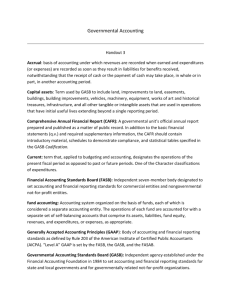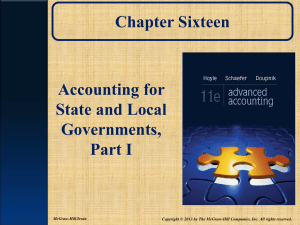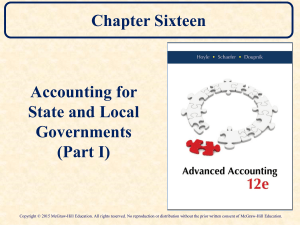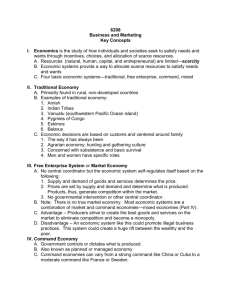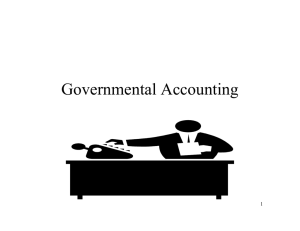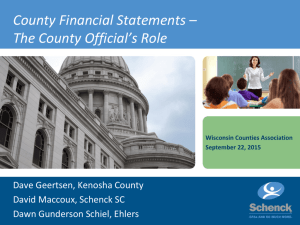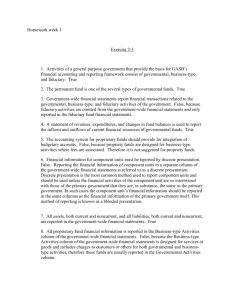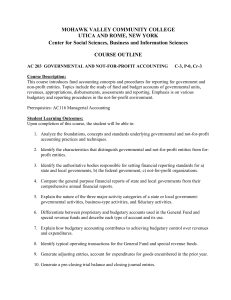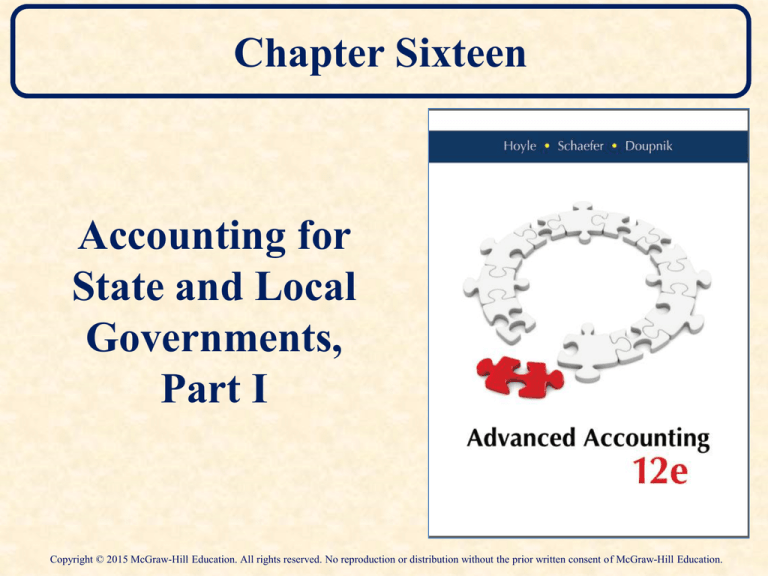
Chapter Sixteen
Accounting for
State and Local
Governments,
Part I
Copyright © 2015 McGraw-Hill Education. All rights reserved. No reproduction or distribution without the prior written consent of McGraw-Hill Education.
Learning Objective 16-1
Explain the history of and
the reasons for the unique
characteristics of the financial
statements produced by state
and local governments.
16-2
Importance of Governmental Accounting
Why is it different than “for profit” businesses?
Allocation of limited resources to unlimited causes
Absence of profit motive
primary purpose is to provide services in accordance
with public policy goals
Serves a broader group of stakeholders
Exist longer and are not typically subject to dissolution
16-3
Governmental Accounting
Governmental Accounting Standards Board (GASB),
created in 1984, serves as the public sector counterpart of
FASB.
In Concepts Statement No. 1, GASB identified three basic
groups of users of governmental accounting information:
Citizenry
Legislative and oversight bodies
Investors and creditors
Requires two sets of financial statements
16-4
Learning Objective 16-2
Differentiate between the two
sets of financial statements
produced by state and local
governments.
16-5
Two Sets of Financial Statements
GASB requires two distinct sets of statements by state
and local governments, each with its own unique
principles and objectives.
Fund Financial
Statements
Show restrictions on the
use of resources, and
report current revenues
and expenditures from
certain activities.
Government-wide
Financial Statements
Report all revenues and
costs with a long term
focus. Of interest to
creditors, to assess the
likelihood of being paid.
16-6
Fund Financial Statements
Report on individual government activities
during the current year.
Primary measurement focus is current
financial resources especially cash and
receivables.
Assess fiscal accountability in raising and
utilizing money.
The timing of recognition, in most cases, is
based on modified-accrual accounting.
16-7
Government-wide Financial Statements
Report on financial affairs as a whole.
Assess operational accountability.
Help users evaluate government’s financial decisions
and long-term stability. Permits stakeholders to:
•
•
•
•
Determine the government’s overall financial position
Understand cost of services
See how programs are financed.
See extent government has invested in capital assets.
Focus on all economic resources.
Utilizes accrual accounting.
16-8
Two Sets of Financial Statements
Comparison of the two sets of financial statements
required by GASB
16-9
Learning Objective 16-3
Understand the reason that
fund accounting has traditionally
been a prominent factor in the
internal recording of state and local
governments.
16-10
Internal Recordkeeping - Fund Accounting
Governmental units report a diverse array of
activities financed from numerous resources.
Governments operate through many relatively
independent departments and functions.
Accounting for each activity is maintained in a
quasi-independent, bookkeeping system – a fund.
Separate information is accumulated for every
activity such as: library, school system, fire
department, road construction, and more.
16-11
Learning Objective 16-4
Identify the three fund types
and the individual fund categories
within each.
16-12
Fund Accounting Classification
All funds fall into one of three broad
classifications.
Governmental
Funds
Proprietary
Funds
Fiduciary
Funds
Accounting for
activities
related to
serving the
public.
Accounting for
business-type
activities.
Accounting for
financial
resources held
for others as
trustee.
16-13
Governmental Funds
Dominate because of a service orientation.
Internal accounting system maintains individual funds
for every distinct service function.
Each fund accumulates and expends current financial
resources to achieve one or more desired public goals.
Governmental funds are subdivided into five categories:
•
•
•
•
•
General Fund,
Special Revenue Funds,
Capital Projects Funds,
Debt Service Funds, and
Permanent Funds.
16-14
Governmental Funds General Fund
GASB’s definition of the General Fund is:
“to account for and report all financial resources not
accounted for and reported in another fund.”
Implies that it records only miscellaneous revenues and
expenditures , but
It accounts for many of a government’s most important
ongoing functions.
2011 fund financial statements for the City of
Baltimore, Maryland, disclosed 11 major areas of
current expenditures within its General Fund.
16-15
Governmental Funds Special Revenue Fund
Account for resources that are restricted or committed
for a specific purpose other than debt payments or capital
projects.
Donor stipulations or legislative mandates require these
financial resources must be spent in a designated fashion.
St. Paul, Minnesota, reported approximately $95 million
of revenues within over 25 individual Special Revenue
Funds during the 2011 fiscal year for:
Rent received from use of the Municipal Stadium
Administration Fees for charitable gambling
Money received from solid waste and recycling programs
Cable television franchise fees.
16-16
Governmental Funds Capital Projects Fund
Accounts for capital resources assigned for capital
outlays such as bridges, schools, and other major
governmental facilities.
Funding comes from a number of sources.
The actual asset to be obtained is not recorded, only
the money to finance its purchase or construction is.
The Lexington-Fayette Urban County Government
in Kentucky reported, as of June 30, 2012, that it
held more than $20.4 million in financial resources in
18 different Capital Projects Funds
16-17
Governmental Funds Debt Service Funds
Record financial resources accumulated to pay long-
term liabilities and interest when due.
Does not account for the government’s actual debt.
Debt Service Funds monitor balances currently
available to make the payment to satisfy long-term
liabilities.
In 2012, Birmingham, Alabama, reported $34
million in cash and investments held to pay its longterm debt.
It paid $21. 6 in principal payments and $13.7 million in
interest payments from its debt service funds.
16-18
Governmental Funds Permanent Funds (Endowments)
Account for financial resources restricted by external
donors, contract, or legislation with stipulation that
the principal can never be spent, but any income can
be used for a designated purpose.
In 2011, Dallas, Texas reported nearly $8 million in
funds to maintain four different parks and help
finance other municipal projects.
These gifts are referred to as endowments.
16-19
Proprietary Funds
Category accounts for government activities that
assess a user fee.
User charges help recover some of the costs.
Accounting resembles that of a for-profit activity accrual accounting is used to recognize assets and
liabilities.
Proprietary funds are broken into two divisions:
Enterprise Funds
Internal Service Funds
16-20
Proprietary Funds Enterprise Funds
May be used to account for any government
activity that is financed, at least in part, by user
charges.
An activity MUST be accounted for here if, any
one of these conditions below are met . . .
Revenues generated by the activity provide the sole
security for the activity’s debts.
Laws or regulations require recovering the
activity’s costs through fees and charges.
Fees are set at prices intended to recover costs.
16-21
Proprietary Funds Internal Service Funds
Account for any operation that provides services to
ANOTHER governmental department for a fee.
Services are provided for the primary benefit of parties
with the government.
Accounted for similar to for-profit operations in the
private sector.
In 2012, Lincoln, Nebraska reported eight operations
that were accounted for as separate internal service
funds that provided a variety of services including
∙ central data processing ∙ engineering ∙ insurance ∙ copy
∙ maintenance facility for city and police vehicles ∙
graphic arts and ∙ operation of facilities for government
functions.
16-22
Fiduciary Funds
Account for assets that are held in a trustee or
agency capacity for external parties.
Money cannot be used to support government’s
own programs.
Use the economic resources measurement focus
and accrual accounting.
Funds are omitted entirely from government-wide
financial statements.
Separate statements are included within the fund
financial statements.
16-23
Fiduciary Funds
Investment Trust
Investments held on behalf of others
Private-Purpose Trust
Principal and interest are both for the benefit of
parties outside the government
Unclaimed property is usually recorded here
Pension Trust
Employee retirement benefits (quite large)
Agency Funds
Resources held by a government as an agent for
others (taxes and tolls collected and transferred)
16-24
Learning Objective 16-5
Understand the basic structure
of government-wide financial
statements and fund financial
statements (as produced for
the governmental funds).
16-25
Government-wide Financial Statements
Two statements are required:
1) Statement of Net Position
2) Statement of Activities
Reporting is separated into:
Governmental activities
All governmental funds and most internal
service funds.
Business-type activities
All enterprise funds and remaining internal
service funds.
16-26
Statement of Net Position
16-27
Statement of Net Position
The economic resources measurement focus is used in
government-wide financial statements. All assets and
liabilities are reported, but GASB has identified several
balances that do not qualify as either assets or liabilities.
These amounts are shown as deferred outflows or
deferred inflows of resources. The final section, the net
position category, indicates
(1) the amount of capital assets being reported less
related debt,
(2) legal or external restrictions on the use of any assets
or resources, and
(3) the total unrestricted amount.
16-28
Statement of Activities
16-29
Statement of Activities
The statement of activities provides details about
revenues and expenses separated into governmental
activities and business-type activities.
Direct expenses and program revenues are shown for
each government function. Program revenues include
fines, fees, and grants that the specific activity
generates. Thus, a single net revenue or net expense is
determined for each function to indicate the financial
burden or financial benefit to the government and its
citizens.
16-30
Fund Financial Statements
Two statements are required:
1) Balance Sheet
2) Statement of Revenues, Expenditures, and
Other Changes in Fund Balance
Three categories in the second fund financial
statement are addressed in detail:
1) Revenues
2) Expenditures
3) Other Financing Sources (Uses)
16-31
Fund Financial Statements
Fund Financial statements differ from the GovernmentWide financial statements for three reasons:
1) The Internal Service Funds are grouped with the funds
they benefit.
2) Governmental activities use the economic resources
measurement basis focus, and the current financial
resources measurement focus is used for governmental
funds.
3) The timing of recognition is different, and the
differences create the need for reconciliations between
the totals on the two types of statements.
16-32
Fund Financial Statements – Balance Sheet
16-33
Statement of Revenues, Expenditures, & Changes in
Fund Balances
16-34
Statement of Revenues, Expenditures, & Changes in
Fund Balances
Governmental accounting does not require a
stockholders’ equity section on the balance sheet.
The term “fund balance” is used to report the amount of
the net current financial resources at that time for each
fund. These fund balances are reported within five
categories:
Fund-Balance—Nonspendable
Fund-Balance—Restricted
Fund-Balance—Committed
Fund-Balance—Assigned
Fund-Balance—Unassigned
16-35
Learning Objective 16-6
Record the passage of a budget as
well as subsequent encumbrances
and expenditures.
16-36
Procedures - Importance of Budgets
The budget serves several purposes:
– Expresses public policy
– Expresses financial intent
– Provides control by establishing spending limits
– Compares actual results to the budget as a means
of evaluating performance
– Indicates whether there is sufficient revenue to
pay for expenditures
16-37
Procedures – Recording Budgetary
Entries Example
A town enacts a motel excise tax to promote tourism and
conventions. For 2015, the tax is expected to generate $490,000
in Special Revenues. The city council authorizes expenditures of
$420,000 including $200,000 for salaries, $30,000 for utilities,
$110,000 for supplies, and $80,000 for advertising.
16-38
Procedures –
Encumbrances
In a governmental unit, purchase commitments and
contracts are recorded, even though they may not yet
represent liabilities.
A recorded commitment or contract is an
“encumbrance.”
When the purchased item is received, the expenditure
account is recognized and the encumbrance account is
removed.
Budget
Encumbrance
Expenditure
16-39
Procedures for
Encumbrances Compared
For Fund-Based Financial Statements:
An entry is required to record the encumbrance.
An entry is required when the item is received.
At the end of the fiscal period, remaining
commitments are removed by reversing the original
journal entry.
For Government-Wide Financial Statements:
No entry is required to record the encumbrance.
An entry is required when the order is filled.
16-40
Learning Objective 16-7
Understand the reporting of capital
assets, supplies, and prepaid expenses
by a state or local government.
16-41
Procedures –
Fixed Assets
Virtually no assets are recorded within the fund
statements for governmental funds.
The expenditure for capital assets is recorded at
acquisition and closed out at the end of the fiscal
period.
Fund financial statements report the amount
expended each period by the governmental funds
for capital assets and infrastructure items.
16-42
Learning Objective 16-8
Determine the proper timing for the
recognition of revenues from various
types of nonexchange transactions.
16-43
Procedures –
Recognition of Revenues
Revenue for governmental organizations differs from
revenue for business. Governmental revenue is not true
revenue for which an earnings process exists. The revenue
is derived from “nonexchange transactions” for which the
government does not provide a direct and equal benefit for
the amount received.
Nonexchange Transactions Classifications
Derived Tax Revenues
Imposed Nonexchange Revenues
Government-mandated Nonexchange Transactions
Voluntary Nonexchange Transactions
16-44
Learning Objective 16-9
Account for the issuance of longterm bonds and the reporting of
special assessment projects.
16-45
Procedures –
Issuance of Bonds
Bond proceeds are not revenue, but the proceeds
serve as a major source of financing for many sate
and local governments.
The proceeds must be repaid, so the government
recognizes no revenue.
Government-wide financial statements recognize
cash received and debt incurred.
Fund financial statements recognizes the cash
received, but does not record the debt as a claim
on current financial resources.
16-46
Special Assessments - Accounting
Governments may provide improvements or services that
benefit particular properties.
They may assess the costs, in total or in part, to the
property owners for paving and constructing:
– Streets
– Curbs
– Sidewalks
– Sewers and drains
– Water lines
Usually financed by debt issuance and liens on the
benefited property (to ensure reimbursement).
16-47
Learning Objective 16-10
Record the various types of
monetary transfers that occur
within the funds maintained by a
state or local government.
16-48
Interfund Transactions
Commonly used, particularly monetary transfers from
the General Fund
Normally reported as “other financing source” and
“other financing use” within the fund-based financial
records
Intra-activity transactions between two government or
two enterprise funds are not reported in the governmentwide financial statements because they create no net
impact.
Interactivity transactions occur between governmental
and enterprise funds and are reported on governmentwide financial statements
16-49

